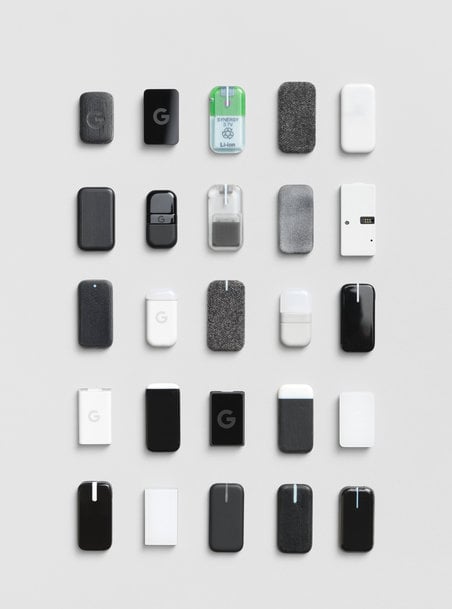www.magazine-industry-usa.com
29
'21
Written on Modified on
WHERE INNOVATION HAPPENS
Google ATAP uses 3D printing to design brand-new tech experiences.

At Google’s Advanced Technology and Projects (ATAP) group*, problem-solving is key.
“Our team is really looking for solutions. We’re always searching and exploring new technologies, but in the end the most important thing is application-driven innovation,” explains Bryan Allen, technical program manager and ATAP Lab lead. The team specializes in 3D printing and advanced fabrication, so it works with many different additive manufacturing technologies, including PolyJet technology from Stratasys.
Jacquard by Google
Led by Ivan Poupyrev, the Jacquard project team within Google ATAP is working to create innovative products across a wide range of applications, exploring how technology can be more accessible, helpful, and ultimately human.
Jacquard by Google is a wearable platform designed to bring the digital world into everyday experiences – without disrupting the user’s lifestyle. The platform includes an app and a physical tag that can be incorporated into a number of soft goods, allowing for interactive digital experiences without needing to physically hold a device. The Jacquard Tag itself looks unassuming, but that’s entirely purposeful.
“Our designs are meant to disappear. They’re meant to fit seamlessly into our aesthetic surroundings,” says Allen.
That’s why the physical Jacquard component is a small, sleek tag that can be modified to fit into almost any product, from a backpack to a shoe. These are products that aren’t typically associated with digital experiences. One Jacquard application incorporated the tag into the sleeve of a denim jacket. A set of motions, like swiping or tapping the sleeve, allows the user to perform actions such as pausing music, taking a photo, or answering a phone call.
Bringing Flexibility to Product Development
The team faced a complex task: gracefully merging a hard goods and soft goods product pipeline. This challenging project required a versatile array of manufacturing techniques and technologies, both traditional and additive. PolyJet technology provided the flexibility the ATAP team needed.
The versatility of PolyJet allows designers to jump in at any stage of the design process and create the prototypes they need, from single-color concept models to functional multi-material prototypes. Parts printed with literally flexible materials allow for further part realism. PolyJet printers like the J8 Series combine excellent resolution with a wide range of material offerings and workflow capabilities. These printers are also Pantone Validated, offering thousands of unique shades and the capability to simulate surface textures from wood grain to leather.
Allen explains that PolyJet printers provide a good balance between speed, material performance, and functional fidelity – the last of which is a crucial step in the ATAP product development process. “We’re talking about things that didn’t exist before,” he says. The team needs to be able to closely replicate the multi-material assembly of the final product, and that process needs to happen fast. Typically, getting a multi-material prototype would take weeks, but with PolyJet, the ATAP team can hit print at the end of the day and have a high-fidelity model in engineers’ hands the next morning.

Design iterations of the Jacquard Tag 3D printed with Stratasys PolyJet technology
Stratasys has made that process even easier with the recent announcement of support for KeyShot 10 rendering software and the 3MF file format. By saving designs to 3MF, KeyShot produces files ready for printing, with accurate colors and displacement maps to three-dimensionally simulate textures. The Google ATAP team was a key beta customer.
“A lot of designers are using KeyShot. The closer the end part coming off the printer looks to the KeyShot rendering and the easier it is to go from the designer’s vision to the final print, the better,” Allen says.
The result is that designers get more questions answered faster. In other words, says Allen, you’re “de-risking” the process. “You’re buying design time to explore and optimize your solutions and get critical needs done so you can move into the next stages.”
Having that extra time is critical for groups like ATAP, which is focused on creating truly novel products that enhance tech experiences. The team looks to develop products that can be integrated in multiple areas, with the versatility to help users in a range of different environments and experiences. That, explains Allen, is why Jacquard is so exciting.
Human Analogs to Enable What’s Next
So far, in addition to the denim jacket, the ATAP team has used the Jacquard platform to introduce a wearable gaming athletic shoe and a smart backpack, with more to come.
Meanwhile, the team continues to use 3D printing in new ways. ATAP is even beginning to use Stratasys’ Digital Anatomy technology to improve functional material performance. The PolyJet-based Digital Anatomy 3D Printer replicates the appearance, texture, and responsiveness of human anatomy, including tissue, bone, and muscle. Designed to improve surgical preparedness and training and help test new medical devices, it’s found a home with the Google ATAP Lab team as well. After all, they’re designing devices that need to wear well on the human body.
“The closer replication of human body materials opens up entirely new avenues of exploration,” Allen says.
Clearly, PolyJet is helping bring these novel experiences to life. Allen says as 3D printing continues to evolve and improve, the final printed parts will even more closely match designer intent and real-world materials.
“Printers are really catching up to how designers think about design and materials,” Allen explains. “The future is coming a lot faster than we thought it would, and at Google ATAP, we’re building the capabilities for us to be able to predict what’s possible.”
www.stratasys.com

